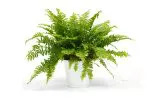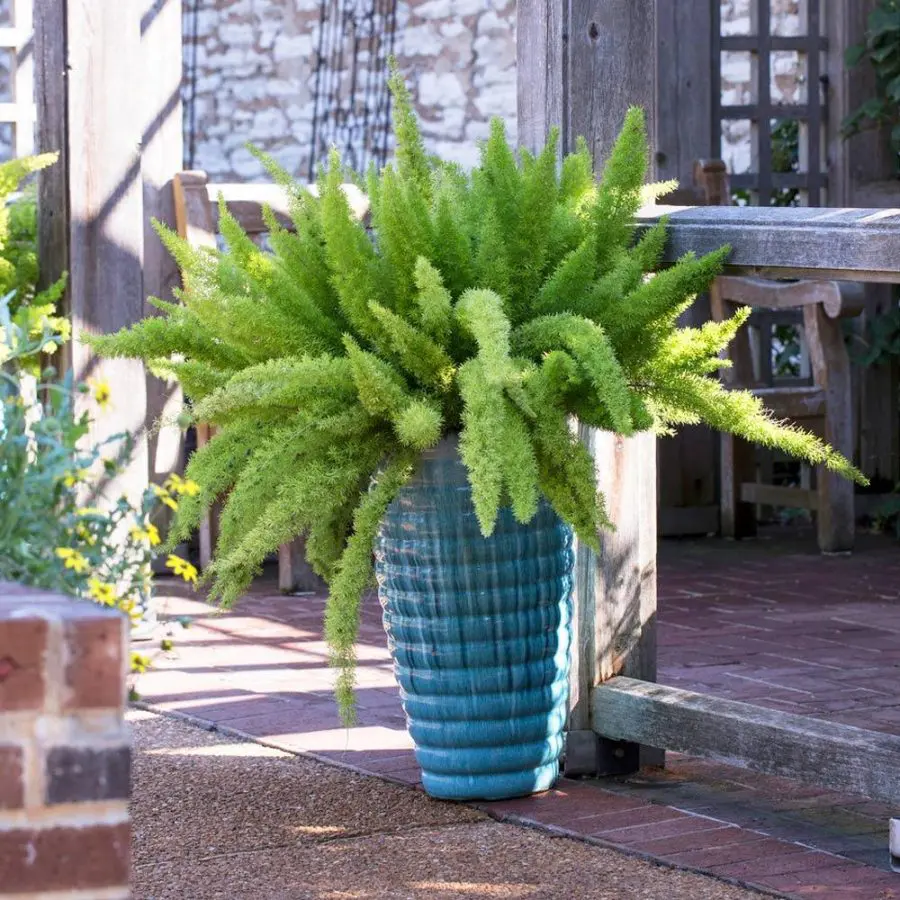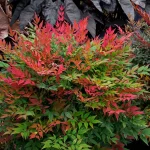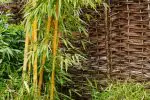This post contains affiliate links. If you buy something from one of our links we may earn a commission. Thanks
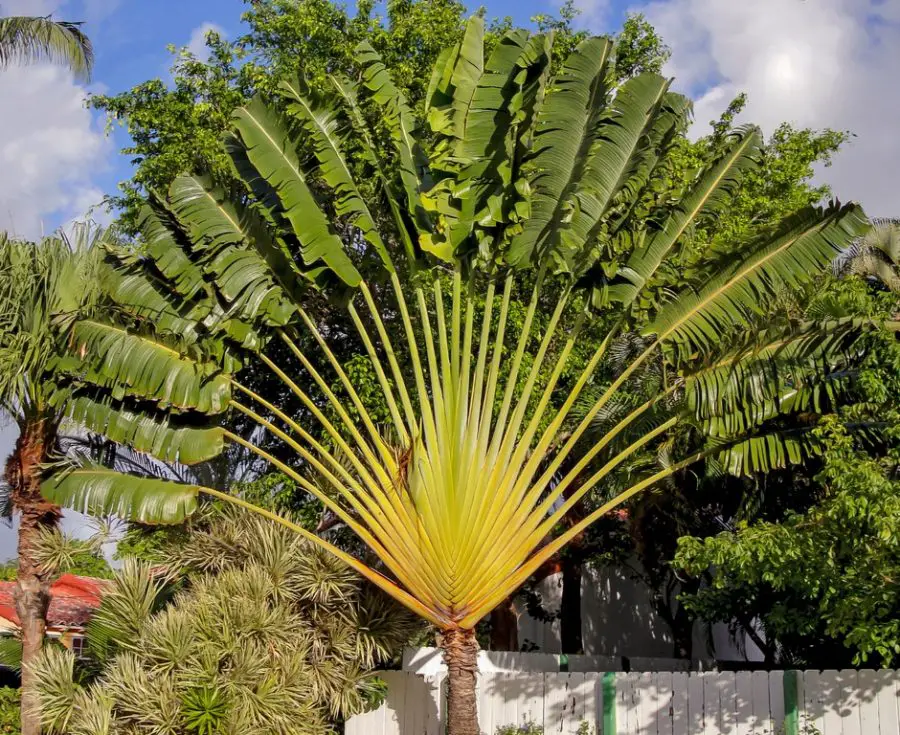
Looking to bring some tropical vibes indoors? Check out our guide to Travellers Palm indoor care and learn how to keep this stunning plant happy and healthy!
To grow Travellers Palm or Ravenala madagascariensis indoors, choose a location with bright, indirect light and ample space due to its large size. Use well-draining soil and keep it consistently moist. Provide high humidity and temperatures between 65-70°F. Fertilize with a balanced liquid fertilizer every 6-8 weeks.
Are you dreaming of turning your home into a lush, tropical paradise? Look no further than the Travellers Palm!
This stunning plant can add a touch of the exotic to any room, but it does require some TLC.
In this guide to Travellers Palm indoor care, we’ll give you all the tips and tricks you need to keep your plant healthy and thriving. So let’s get started and bring a bit of the tropics indoors!
Introduction To Travellers Palm Indoor Care
Hey there! Are you a plant lover looking to add a unique and exotic touch to your indoor jungle?
Look no further than Ravenala madagascariensis, commonly known as the Traveller’s Palm.
Other common names include the traveller’s tree, traveller’s palm or East-West palm.
Despite its name, this striking plant isn’t actually a palm tree at all!
Native to Madagascar, the Traveller’s Palm is known for its large, fan-shaped leaves and ability to add a touch of the tropics to any space.
However, like all plants, it requires proper care to thrive indoors.
In this guide, we’ll cover everything you need to know about Ravenala madagascariensis indoor care, so you can keep your plant happy and healthy for years to come. Let’s dive in!
Get to Know the Traveller’s Palm
The Traveller’s Palm scientific name is Ravenala madagascariensis. It is a large, tropical plant that is native to Madagascar.
Despite its name, it is not actually a true palm tree, but rather a member of the Strelitziaceae family.
It is closely related to Strelitzia nicolai commonly known as the wild banana tree or giant white bird of paradise.
The plant can grow up to 30 feet tall outdoors, but it can also be grown as an indoor plant with proper care.
The legendary Travelers Palm is known for its large, fan-shaped leaves that resemble a traveller’s fan.
The Traveller’s Palm actually comes from the fact that the plant was traditionally used by travellers in Madagascar as a source of water.
A thirsty traveller could supposedly take advantage of the plant’s large, flat huge leaves which are arranged in such a way that they can collect rainwater, which can then be accessed by cutting a notch in the stems leaf bases of the plant.
The term East-West palm comes from the East-West orientation of the leaves which can be used as a crude compass for a traveller.
Benefits of Growing the Traveller’s Palm Indoors
One of the biggest benefits of growing a Traveller’s Palm indoors is the tropical touch it can bring to your space.
The plant’s large leaves and unique shape make it a great statement piece in any room. Additionally, the Traveller’s Palm is a great air purifier, as it can remove toxins from the air and increase humidity levels.
This makes it especially beneficial for those living in urban areas or places with dry climates.
Proper Care is Key
To keep your Traveller’s Palm healthy and thriving indoors, it is important to provide it with proper care.
This includes ensuring that it is planted in well-draining soil and a pot with drainage holes, providing it with enough light and keeping it hydrated with regular watering.
The plant also requires warm temperatures and high humidity levels, so it may be necessary to use a humidifier or mist the leaves regularly.
Finally, fertilizing the plant every few months can help promote healthy growth and vibrant leaves. With proper care, your Traveller’s Palm can be a stunning addition to your indoor jungle!
Cold Tolerance:
The Travelers Palm Tree is an impressive natural palm that can withstand cold temperatures as low as 20 degrees fahrenheit.
It thrives in USDA Zones 9a (where temperatures range from 20 to 25 F) up to Zone 11 (where temperatures stay above 40 F).
While it prefers full sun, it can also grow in areas with light shade.
Planting
Ready to bring a touch of the tropics to your indoor space? Planting a Traveller’s Palm (Ravenala madagascariensis) can add a unique and exotic flair to your indoor jungle.
While the plant can grow up to 30 feet tall outdoors, it can also be grown in a pot indoors with proper care.
The good news is it won’t get that big in a pot. If you have lots of space and a sunny spot it can be a great option for you.
In this section, we’ll cover everything you need to know about planting a Traveller’s Palm, including selecting the right soil and pot, and how to properly plant and care for your new plant.
So let’s get started and make your indoor space a true oasis with a beautiful Traveller’s Palm!
Choosing the Right Container
When selecting a container for your Traveller’s Palm, it’s important to choose a pot that is large enough to accommodate the plant’s root system.
The pot should have drainage holes at the bottom to allow excess water to escape and prevent the soil from becoming waterlogged.
You can choose a decorative pot to enhance the plant’s aesthetic appeal, but make sure it is large enough to provide ample room for the plant’s roots to grow.
Choosing the Right Soil
The Traveller’s Palm requires well-draining soil that is rich in organic matter.
You can use a commercial potting mix designed for tropical plants or create your own mix by combining equal parts of peat moss, perlite, and sand.
Avoid using heavy, clay soils that can hold onto moisture and cause root rot.
Coco coir is a peat moss substitute
If you prefer not to use peat moss, a coco coir and perlite mix can be a great alternative for growing your Traveller’s Palm.
Coco coir is a renewable resource made from coconut fibers, and it is an eco-friendly option that is becoming increasingly popular among gardeners.
When combined with perlite, a lightweight, volcanic rock that promotes drainage, the result is well-draining, nutrient-rich soil that can help your Traveller’s Palm thrive.
Just be sure to mix the two ingredients in equal parts and add them to your potting mix to provide your plant with the ideal growing conditions.
Planting the Traveller’s Palm
To plant your Traveller’s Palm, fill the bottom of the pot with a layer of gravel or rocks to improve drainage.
Add a layer of soil on top, then gently remove the plant from its original container, being careful not to damage the roots.
Place the plant in the new pot and fill the space around it with soil, making sure to leave about an inch of space between the soil and the rim of the pot.
Water the plant thoroughly and place it in a bright, indirect location with warm temperatures and high humidity levels.
With proper care, your Traveller’s Palm will thrive and bring a touch of the tropics to your indoor space!
Lighting
When it comes to indoor plants, lighting is one of the most important factors to consider.
The Traveller’s Palm (Ravenala madagascariensis) is no exception, and it requires bright light to grow and thrive.
In this section, we’ll cover everything you need to know about lighting for your Traveller’s Palm, including the ideal location for your plant, the type of light it needs, and how to ensure your plant gets enough light.
So let’s shed some light on this topic and help your Traveller’s Palm reach its full potential!
The Traveller’s Palm requires sun to grow and thrive. It is a tropical plant that is adapted to bright sunlight, so it needs a lot of direct sunlight to grow well.
However, it is important to note that too much full sun exposure can scorch the plant’s leaves, so it’s important to provide some partial shade during the hottest part of the day, especially for younger trees.
In this section, we’ll cover everything you need to know about providing the right amount and type of sunlight for your Traveller’s Palm, so let’s get started!
The Importance of Proper Lighting for the Traveller’s Palm
As a tropical plant, the Traveller’s Palm requires ample sunlight to grow and thrive.
Adequate lighting is essential for the plant’s health, as it helps to facilitate photosynthesis and promotes healthy growth.
Without proper lighting, the plant may become weak, leggy, or fail to produce new leaves altogether.
So it’s important to ensure that your Traveller’s Palm is getting enough light to support its growth and development.
Recommended Lighting Conditions for the Plant
The ideal lighting conditions for the Traveller’s Palm are bright, direct sunlight.
The plant should receive at least six hours of direct sunlight per day to promote healthy growth.
You can place your plant in a south-facing window or in a location with plenty of natural light to provide the optimal lighting conditions.
If your home does not receive enough natural light, you may need to supplement with artificial lighting using grow lights.
Be sure to position the lights above the plant and keep them on for at least 12-16 hours per day.
Tips for Adjusting Lighting as Needed
While the Traveller’s Palm requires plenty of sunlight to grow, it’s important to be mindful of its needs and make adjustments as needed.
If you notice that the leaves are starting to brown or curl, it may be a sign that the plant is getting too much direct sunlight.
In this case, you can move the plant to a location with more shade or use a sheer curtain to filter the light.
On the other hand, if the plant is not getting enough light, you may notice that the leaves are pale or yellowish due to low light levels.
In this case, you can move the plant to a sunnier location or supplement with artificial lighting.
By paying attention to your Traveller’s Palm’s needs and making adjustments as needed, you can help ensure that it receives the ideal amount and type of light for optimal growth and health.
Watering
Watering is another important aspect of caring for your Traveller’s Palm. While the plant is tolerant of some drought, it also needs consistent moisture to thrive.
In this section, we’ll cover everything you need to know about watering your Traveller’s Palm, including how often to water, the best watering practices, and signs that your plant may be getting too much or too little water.
So let’s dive in and learn how to keep your Traveller’s Palm happy and hydrated!
The Importance of Proper Watering for the Traveller’s Palm
Proper watering is crucial to the health of your Traveller’s Palm. While the plant can tolerate some periods of drought, it also needs consistent moisture to thrive.
Overwatering can lead to root rot, while underwatering can cause the leaves to wilt and brown.
So it’s important to get the watering just right to keep your Traveller’s Palm healthy and happy.
Recommended Watering Schedule for the Plant
The recommended watering schedule for the Traveller’s Palm depends on several factors, such as the plant’s size, the type of soil it’s in, and the amount of light and humidity it’s receiving.
In general, you should aim to water your Traveller’s Palm deeply once a week during the growing season, and reduce the frequency during the winter months.
It’s important to allow the soil to dry out slightly between watering to prevent overwatering and root rot.
You can also use a moisture meter or stick your finger about an inch into the soil to check the moisture level before watering.
Tips for Adjusting Watering as Needed
If you notice that your Traveller’s Palm is not thriving, it may be a sign that you need to adjust your watering routine.
Place your fingers into the top 2 inches of soil. If it is dry it is time to water.
For instance, if the leaves are wilting or turning yellow, it may be a sign of overwatering.
In this case, you should reduce the frequency of watering and make sure that the soil is well-draining.
On the other hand, if the leaves are dry and crispy, it may be a sign of underwatering.
In this case, you should increase the frequency of watering and make sure that the soil is moist but not waterlogged.
By paying attention to your Traveller’s Palm’s needs and adjusting your watering routine accordingly, you can help ensure that your plant stays healthy and thriving.
Temperature and Humidity
Temperature and humidity are important factors to consider when it comes to the care of your Traveller’s Palm.
This tropical plant thrives in warm and humid conditions, so it’s important to provide the right environment to ensure its health and vitality.
In this section, we’ll cover everything you need to know about the optimal temperature and humidity range for your Traveller’s Palm, as well as tips for adjusting these conditions as needed.
So, let’s get started and learn how to create the perfect microclimate for your Traveller’s Palm!
The Importance of Proper Temperature and Humidity for the Traveller’s Palm
As a tropical plant, the Traveller’s Palm thrives in warm and humid conditions.
It’s important to maintain the proper temperature and humidity levels to promote healthy growth and prevent problems like leaf yellowing or browning.
By paying attention to your plant’s environment and making necessary adjustments, you can help ensure that your Traveller’s Palm stays happy and healthy.
Recommended Temperature and Humidity Conditions for the Plant
The recommended temperature range for the Traveller’s Palm is between 65-85°F (18-29°C).
It’s important to avoid sudden temperature drops or cold drafts, which can damage the plant.
Additionally, the optimal humidity level for the Traveller’s Palm is around 50-60%.
If the air is too dry, the leaves can dry out and turn brown.
To increase humidity levels, you can use a humidifier or place a tray of water near the plant.
You can also mist the leaves with water to add moisture to the air.
Tips for Adjusting Temperature and Humidity as Needed
If you notice that your Traveller’s Palm is struggling or showing signs of stress, it may be a sign that the temperature or humidity levels are not ideal.
If the temperature is too low, you can move your plant to a warmer location or use a space heater to increase the temperature.
If the humidity is too low, you can use a humidifier or place a tray of water near the plant. On the other hand, if the humidity is too high, you can reduce humidity by improving ventilation or moving the plant to a less humid location.
By monitoring the temperature and humidity levels and making necessary adjustments, you can help your Traveller’s Palm thrive.
Fertilization
 Fertilization is an essential part of caring for your Traveller’s Palm.
Fertilization is an essential part of caring for your Traveller’s Palm.
Providing your plant with the right nutrients can help promote healthy growth and prevent issues like yellowing or browning of the leaves.
In this section, we’ll cover everything you need to know about fertilizing your Traveller’s Palm, including the best types of fertilizer to use, how often to fertilize, and tips for applying fertilizer properly.
So, let’s dive in and learn how to keep your Traveller’s Palm looking its best!
The importance of proper fertilization for the Traveller’s Palm:
Fertilization is essential to keep your Traveller’s Palm healthy and promote optimal growth.
Proper fertilization can help provide the necessary nutrients that the plant needs to flourish, such as nitrogen, phosphorus, and potassium.
These nutrients support healthy leaf growth and can help prevent the yellowing or browning of the leaves.
Recommended fertilization schedule for the plant:
It’s recommended to fertilize your Traveller’s Palm once a month during the growing season, which is typically from spring to fall.
You can use a balanced liquid fertilizer or slow-release fertilizer spikes.
Slow-release fertilizer spikes can provide nutrients for up to three months, making them an excellent option for busy plant owners.
Tips for adjusting fertilization as needed:
If you notice that your Traveller’s Palm is growing more slowly or the leaves are starting to look pale or yellow, it may be a sign that the plant needs more fertilizer.
However, be careful not to over-fertilize, as this can lead to fertilizer burn and other issues.
Always follow the recommended dosage on the fertilizer package and adjust accordingly if needed.
Also, remember to water your plant thoroughly after fertilizing to help distribute the nutrients evenly throughout the soil.
Pest and Disease Control
One of the challenges of growing any plant is dealing with pests and diseases, and Traveller’s Palm is no exception.
Fortunately, there are steps you can take to prevent and treat common issues that can affect your plant’s health.
In this section, we’ll discuss the most common pests and diseases that can affect your Traveller’s Palm and provide tips on how to identify and control them.
With the right knowledge and care, you can help keep your plant healthy and thriving!
Common problem pests and diseases that affect the Traveller’s Palm:
Some of the most common pests that can affect the Traveller’s Palm include spider mites, mealybugs, and scale insects.
These pests can cause damage to the leaves, stem, and roots of the plant, and may also cause the plant to produce less foliage or have stunted growth.
Diseases that can affect the Traveller’s Palm include leaf spot and root rot, which can cause yellowing and wilting of leaves and even death of the plant.
Prevention and treatment options for these pests and diseases:
The best way to prevent pest and disease issues with your Traveller’s Palm is to provide proper care, including proper watering, fertilization, and lighting.
You can also use natural pest control methods, such as insecticidal soap, neem oil, or a mixture of water and rubbing alcohol.
If you notice signs of disease on your plant, you can treat it with a fungicide or by removing the affected parts of the plant.
Tips for identifying and addressing issues with the plant:
It’s important to regularly inspect your Traveller’s Palm for signs of pests or disease.
Look for yellowing or brown spots on the leaves, webs or silk-like substances on the underside of the leaves, or small, raised bumps on the stems or leaves.
If you notice any of these signs, take action immediately to prevent the issue from spreading.
You can also take preventative measures, such as regularly cleaning the leaves and stems of the plant, to help prevent pests and diseases from taking hold in the first place.
Propagation
Propagation by Division:
One way to propagate a Traveller’s Palm is through division.
You can do this by removing the plant from its container and gently dividing the root ball into two or more sections.
Each section should have a healthy root system and a few stems with leaves attached.
Plant each section into its own container with fresh potting mix and follow the same care instructions as for an established plant.
Traveller’s Palm can produce offsets or suckers, which can be used for propagation through division.
Propagation by Seeds:
Another way to propagate a Traveller’s Palm is by collecting and planting its seeds.
After the plant has produced mature fruits, the seeds can be harvested, cleaned, and sown in a container with fresh potting mix.
Keep the soil moist and warm, and the seeds should germinate in a few weeks.
It’s worth noting that it may take several years for a young plant to mature. You can buy seeds online if your plant is too young to make its own.
This plant can get tall how can you control the height?
If you want to control the height of a Traveller’s Palm, you can prune the stem.
To do this, simply remove the top portion of the stem using sharp pruning shears. This will encourage the plant to grow new shoots from the base, which can help to create a more compact and bushy plant.
However, keep in mind that pruning can also limit growth and may prevent the plant from reaching its full height potential.
Pruning
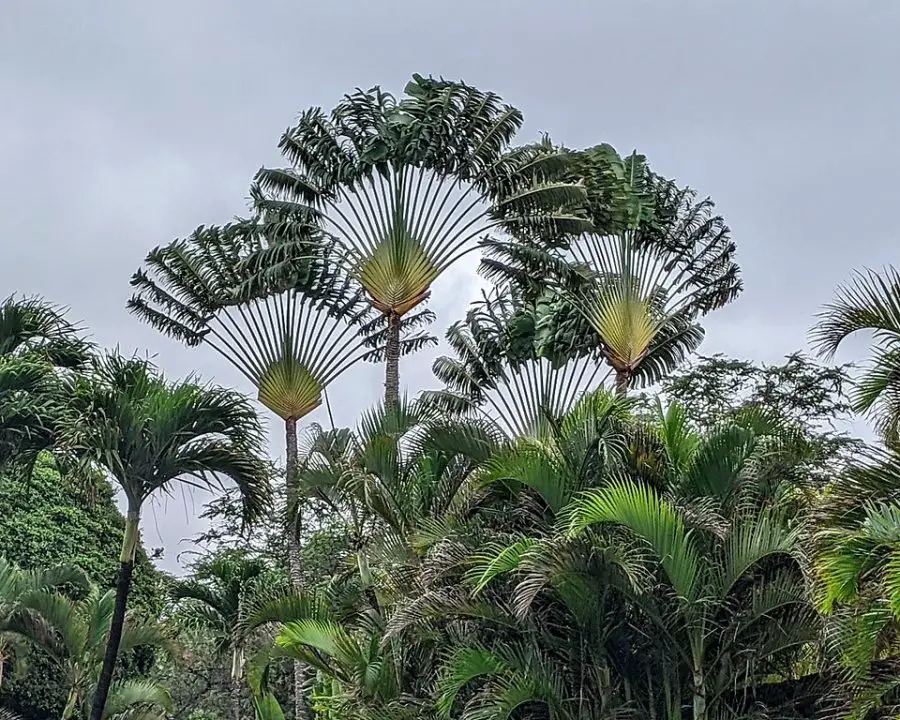
The Travellers Palm tree can grow quite tall, and become a giant of a plant up to 30 feet in the wild.
If you’re growing the plant indoors, it’s unlikely that it will reach this height, but you may still need to prune it to keep it under control.
Pruning can also help encourage fuller growth and remove any dead or damaged leaves.
When pruning the Travellers Palm, it’s important to use clean, sharp tools to avoid damaging the plant.
You can use pruning shears or a sharp knife to make clean cuts.
Start by removing any dead or damaged leaves at the base of the plant.
You can also remove any leaves that are yellowing or browning. Remove any root suckers which can be used to start new plants.
Unlike true indoor palm plants, if you need to control the height of the plant, you can cut back the top portion of the stem.
Make the cut just above a leaf node to encourage new growth. You can also cut back any lateral shoots to encourage fuller growth.
It’s important not to prune the Traveller’s Palm too aggressively, as this can harm the plant.
If you’re unsure about how to prune your plant, it’s best to consult a professional or do some research beforehand to avoid damaging your plant.
Is Ravenala Madagascariensis toxic?
Although Ravenala Madagascariensis or traveller’s tree has been historically consumed medicinally in the form of its fruits, seed oil, and young leaves, it is important to note that the plant is considered mildly toxic to humans.
Therefore, it should not be ingested in any way due to the risk of causing digestive upset and other potential side effects.
Travellers Palm FAQs
Travellers Palm, also known as Ravenala madagascariensis, is an intriguing plant with a palm-like appearance that adds a touch of the tropics to any setting.
Although it’s often mistaken for a palm, it’s actually more closely related to bird-of-paradise plants.
The following FAQ section aims to answer common questions about growing and maintaining a Travellers Palm, whether you’re an experienced plant owner or new to the realm of exotic flora.
Q: How fast does Traveller palm grow?
A: Travellers Palm grows relatively fast in optimal conditions, with growth rates of up to 1-2 feet per year, especially when young.
Q: Do Traveller palms spread?
A: Travellers Palm usually produces offshoots from its base, making it seem like it’s spreading. However, it doesn’t spread invasively.
Q: How big do Travellers Palms grow?
A: In outdoor settings, Travellers Palm can reach heights of up to 30-50 feet. When grown indoors, the growth is limited by the space and care it receives.
Q: What is the lifespan of a Travellers Palm?
A: With proper care, a Travellers Palm can live for several decades.
Q: Why is my Travellers Palm dying?
A: Common issues include overwatering, insufficient light, or nutrient deficiencies. It’s important to assess care practices and adjust accordingly.
Q: Do Travellers Palms like sun or shade?
A: They prefer bright, indirect light but can tolerate some direct sun. Too much direct sun can cause leaf burn, while too little light can stunt growth.
Q: Can you cut back a Travellers Palm?
A: Yes, you can prune dead or yellow leaves and trim back unruly growth. However, take care not to cut the main trunk, as this can kill the plant.
Travellers Palm Indoor Care Final Thoughts
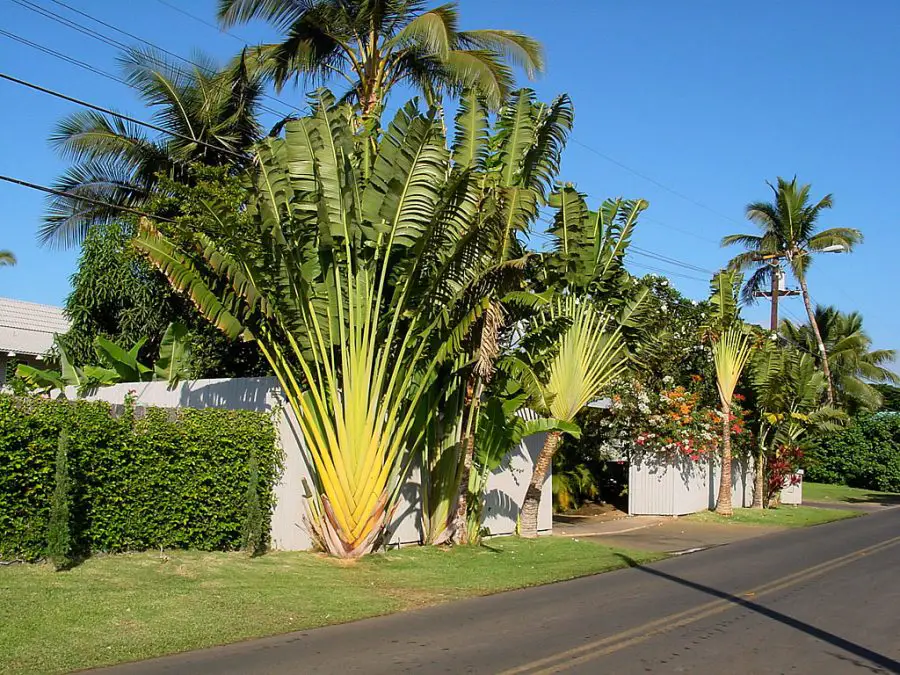
And that’s all there is to know about caring for your Traveller’s Palm indoors!
With proper planting, lighting, watering, temperature and humidity control, fertilization, and pest and disease prevention, your plant will thrive and bring a touch of tropical paradise to your home.
Remember to adjust your care routine as needed based on the unique conditions of your home and the plant’s growth. Happy gardening!
Let’s recap the key points for indoor care of the Travellers Palm
The Traveller’s Palm is a tropical plant known for its fan-shaped leaves that can be grown indoors with proper care.
It is important to choose the right container, soil, and lighting conditions for the plant, as well as to water and fertilize it properly.
The plant thrives in warm, humid environments and is susceptible to certain pests and diseases that require prevention and treatment.
Give Travellers Palm Indoor Care A Try
Growing a Traveller’s Palm indoors is a great way to bring a touch of the tropics into your home.
With the right care and attention, this plant can thrive and add natural beauty to your space.
Remember to keep an eye on the plant’s growth and adjust your care routine as needed to ensure its health and longevity.
We hope this guide has been helpful and wish you happy gardening!
Read more: 20 Benefits Of Keeping Indoor Plants For Improved Lifestyle








